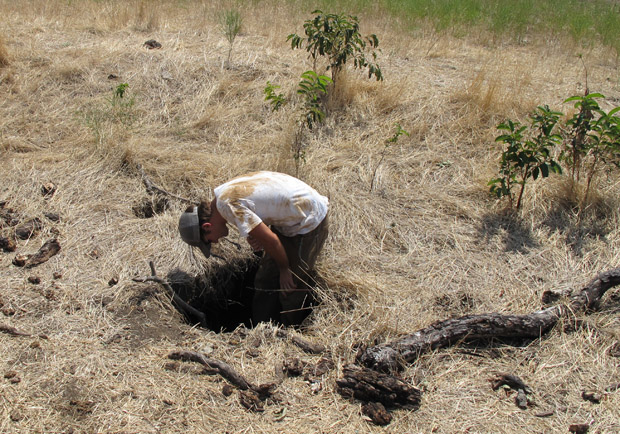
Kevin Blackwood, a hydrologist for the Arbuckle-Karst Conservancy, inspects a new sinkhole over the Arbuckle-Simpson Aquifer in south-central Oklahoma.
Logan Layden / StateImpact Oklahoma


Kevin Blackwood, a hydrologist for the Arbuckle-Karst Conservancy, inspects a new sinkhole over the Arbuckle-Simpson Aquifer in south-central Oklahoma.
Logan Layden / StateImpact Oklahoma

Logan Layden / StateImpact Oklahoma
Kevin Blackwood, a hydrologist for the Arbuckle-Karst Conservancy, inspects a new sinkhole over the Arbuckle-Simpson Aquifer in south-central Oklahoma.
The severe drought that parched large areas of the South and Midwest shows few signs of easing, despite recent rainfall.
The Oklahoma Water Resources Board estimates Oklahoma sits atop more than 300 million acre-feet of groundwater. And no other state has more man-made lakes. With all that water, is it possible Oklahoma has a water surplus, even during this drought?
Oklahoma is actually in a relatively good situation with its water supply, but still, most of the state’s water isn’t where most of the state’s people and agricultural operations are.
For water board Director J.D. Strong, “it depends on how you define ‘surplus.’”
The OWRB approves water use and storage permits.
“It is the case that, the way in which we calculate that water available for permitting, there is still a lot of water available on an average annual basis for us to permit that’s not spoken for right now,” Strong says.
[module align=”left” width=”half” type=”pull-quote”]
“There is still a lot of water available…for us to permit that’s not spoken for right now.”
[/module]
Southeast Oklahoma has the state’s most plentiful surface water, along with the highest poverty rates. And that has some counties looking at turning their liquid assets into cash, as a solution to their current economic problems.
Both North Texas and Oklahoma City are thirsty for southeastern Oklahoma’s water. But the sale and control of the water are issues tied up in court.
Native American tribes lay claim to much of the water based on the 1830 Treaty of Dancing Rabbit Creek, and filed a lawsuit to block its transfer to other areas.

Kevin Blackwood / Arbuckle-Karst Conservancy
East Central University Undergraduate Linzi Thompson prepares to enter the Arbuckle-Simpson Aquifer.
Additionally, surpluses aren’t static and the future is looking dry.
Climate projections for Oklahoma over the next century show slightly increasing temperatures, and droughts that are more frequent and longer lasting.
And it’s the long-term that has water experts, like the University of Oklahoma’s Jonathan Gourley, concerned.
“The Water Resources Board puts out some probabilities where we may have some shortages,” Gourley says. “And it’s basically more problematic in the west and the southwest than it is in the east.”